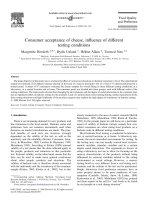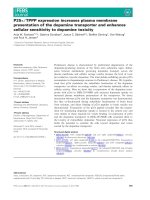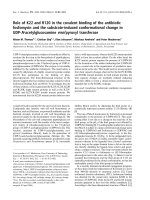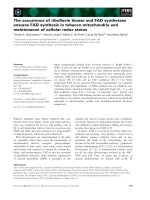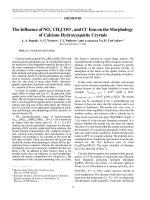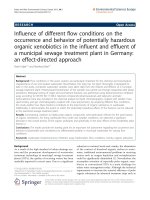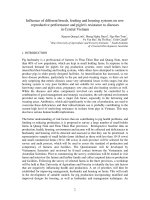Influence of different breeds, feeding and housing systems on sow reproductive performance and piglet''''s resistance to diseases in Central Vietnam pdf
Bạn đang xem bản rút gọn của tài liệu. Xem và tải ngay bản đầy đủ của tài liệu tại đây (252.32 KB, 13 trang )
Influence of different breeds, feeding and housing systems on sow
reproductive performance and piglet's resistance to diseases
in Central Vietnam
Nguyen Quang Linh
1
, Hoang Nghia Duyet
1
, Ngo Huu Toan
1
,
Vu Van Hai
1
, Ha Thi Hue
1
, Colin Cargill
2
1
Hue University of Agriculture and Forestry,Vietnam;
2
South Instutute
of Livestock Development, Australia
1. INTRODUCTION
Pig husbandry is a professional of farmers in Thua Thien Hue and Quang Nam, more
than 80% of sow population, which are kept in small holding farms. In response to the
increased demand for piglets for pig production systems, more small holders have
intensified their breeding and feeding systems, while others have attempted to continue to
produce pigs in older poorly designed facilities. As intensification has increased, so too
have disease problems, particularly in the pre and post-weaning stages, so there are not
only surprising that enteric diseases cause very substantial losses in this stages, but also
housing system is very poor facilities and not suitable for sows and young piglets as
farrowing crates and piglet areas, pregnancy sow area and also heating section as well.
While the diseases and other components involved can usually be controlled by a
combination of good management and strategic vaccination, the sub-optimal environment
provided on many farms is also a major risk factor, especially in the farrowing and
weaning areas. Antibiotics, which add significantly to the cost of production, are used to
overcome these deficiencies and their indiscriminate use is probably contributing to the
current high level of multi-drug resistance in isolates from pigs in Vietnam. This may
also have serious human health implications.
The better understanding of risk factors that are contributing to pig health problems, and
limiting or reducing production, it is proposed to survey a large number of small holder
farms in Quang Nam and Thua Thien Hue provinces. Retrospective baseline data on
production, health, housing, environment and income will be collected and deficiencies in
husbandry and housing will be detected and assessed so that they can be prioritized. A
representative sample of small holder farms (defined as those with less than 10-15 sows)
and small commercial farms (30 to 100 sows) in each province will be selected for the
survey and audit process, which will be used to assess the standard of production and
competency of farmers and facilities. The Questionnaire will be developed by
Vietnamese Scientists and reviewed by E-mail contact between the Vietnamese and
Australian Scientists. Prior to commencing the survey, technicians will be trained to visit
farms and interview the farmer and his/her family and collect required data on production
and facilities. Following the survey of selected farms in the three provinces, a workshop
will be held at Hue University of Agriculture and Forestry to identify the key risk factors
that are negatively influencing health and production. A set of priorities will then be
established for improving management, husbandry and housing on farms. This will result
in the development of suitable models for pig production incorporating modified and
improved designs for housing, as well as husbandry and management techniques. An
1
example of this approach would be the development of a “best practice” farrowing house
design and management system. The design would provide a specialized “microclimate”
for piglets established within a macroclimate for sows and would include improved
hygiene and management for the farrowing area. Based on our collective personal
experience, many small farms in Vietnam fail to provide facilities for farrowing sows and
their litters that are adequate in terms of temperature, dryness and hygiene. Piglets are
often housed in a wet environment and exposed to significant air movement, resulting in
rapid loss in body temperature and outbreaks of diarrhea. Cleaning is often not part of the
routine management process in farrowing pens. The models would be based on
universally accepted features and local requirements that are cost-effective, and easily
established within existing small-scale pig farms. A similar process would be used for
modifying other areas of the production system until a complete production unit has been
developed for both small householder units and small commercial units. The farm and
production models would also be suitable for small co-operative farms.
2. METHODS AND MATERIALS
2.1. Questionnaires: There will be developed and discussed between different project
partners and approach to small holding pig farms in Thua Thien Hue and Quang Nam
2.2. Training for interviewers
Before starting of the survey, project partner coordinator has instructed to interviewers
and examples for practice.
2.3. Farm selection
All of the pig farms, whereas were kept sows and piglets in two provinces (Quang Nam
and Thua Thien Hue) and classified and random selection, 20 - 30 farms per commune
and each province 90 farms at least.
2.3. Visiting and interview on field with every household by appointments with commune
PPC, district agricultural and rural development department.
Dien Ban, Quang Nam province
1)Dien Hoa commune (rice area with large garden)
2) Dien Thang commune (rice area and intensive pig rearing)
3) Dien Nam commune (sandy soil and near Da Nang city)
Thua Thien Hue Province consist:
- Huong Tra District:
Huong Chu commune (rice production area)
Binh Dien commune (up land area)
- Huong Thuy District:
Thuy Phuong commune (large garden with households)
Thuy Duong (rice production, up land and near the Hue city)
Thuy Bang communes (up land area with large garden)
- Phu Vang District: Vinh Phu commune (sandy soil)
2
The lish of households numbers was selected and surveys:
No= Name of commune Province Number of
households
Note
1 Binh Dien Thua Thien hue 30 Upland
2 Thuy Bang Thua Thien hue 20 Upland
3 Thuy Phuong Thua Thien hue 20 Rice, upland
4 Thuy Duong Thua Thien hue 20 Near the city
5 Huong Chu Thua Thien hue 20 Rice are
6 Vinh Phu Thua Thien hue 20 Sandy soil
7 Dien Hoa Quang Nam 30 Rice are
8 Dien Thang Quang Nam 30 Rice area
9 Dien Nam Quang Nam 30 Sandy soil
Total 220
2.4. Variables will be collected in the questionaires and direct interviewing
- General household variables (household characteristics, land uses and area,
professional, labour)
- Technical variables: Number of sows, pigs and other animals, sow reproductive
variables, feeding variables and dietary composition
- Housing design areas, water supplies, floor areas and dimension variables (pen
wall, pen floors, floor hygiene, bedding, bedding replacement).
- Disease infections and treated.
2.5. Statistical and analysis
SPSS will be applied for analysis with relationships, correlations and mean, ANOVA will
be used for analysis.
3. SURVEY RESULTS
3.1. Total of investigated pig farms in two provinces
Table 1. Structure of samples in survey of province
Frequency Percent Valid Percent
Cumulative
Percent
Quang Nam 92 48,9 48,9 48.9
Thua Thien Hue
96 51.1 51.1 100.0
Total
188 100.0 100.0
Table 2. Contributions of different districts
Frequency Percent Valid Percent
Cumulative
Percent
Dien Ban 92 48.9 48.9 48.9
Huong Tra 67 35.6 35.6 84.6
Huong Thuy 29 15.4 15.4 100.0
Total 188 100.0 100.0
3
Table 3. Distributions of sows presented in different communes
Location name Frequency Percent Valid Percent
Cumulative
Percent
Dien Hoa 29 15.4 15.7 15.7
Dien Nam Trung 33 17.6 17.8 33.5
Dien Thang Trung 27 14.4 14.6 48.1
Thuy Phuong 15 8.0 8.1 56.2
Binh Dien 33 17.6 17.8 74.1
Huong Tru 15 8.0 8.1 82.2
Thuy Bang 14 7.4 7.6 89.7
Vinh Phu 19 10.1 10.3 100.0
Total 185 98.4 100.0
Total 188 100.0
The households in two provinces, whereas more sows were kept in different systems with
Quang Nam province, with 92 households in average number of sows was higher than in
Thua Thien Hue province, general evarege is 3.52 ± 2.99 sows in table 4 conducted that
no differences between two provinces P = 0.51, while maximum of 15 sows in Thua
Thien Hue and 20 sows in Quang Nam.
Table 4. Mean of sow numbers in different provinces
N Mean Stdv
95% Confidence
Interval for Mean Minimum Maximum
Quang
Nam
92 3,66 2,79 3,08 4,24 1,00 15,00
Thua
Thien Hue
96 3,37 3,18 2,72 4,02 1,00 20,00
Total 188 3,51 2,99 3,08 3,94 1,00 20,00
The education is very important for farmers, who can learn more techniques in pig
husbandry however, in Central Vietnam. Depend on the age of farmers, in table 5. age of
household headed, more farmers in period of ages 46 -55 (60) years old, 42 % in total
investigated farms.
3.2. Education levels
Table 5. Educational levels of farmers in different areas of Central Vietnam
Educational levels Frequency Percent Cumulative Percent
Illiterate 3 1.6 1,6
Primary
school
35 18.6 20,4
High
primary
81 43.1 64,0
secondry 54 28.7 93,0
College 10 5.3 98,4
Universit
y
3 1.6 100,0
4
Total 188 100.0
Table 5 was conducted the differences between educational levels of farmers in two
provinces, highest percentage of level 3 (primary school), 43.1%, so the differences in
education between two provinces (Hue and Quang Nam). More educational levels, they
can keep less sows and pigs in their systems, herewith a maximum average of sow
number for group of illiterate farmers.
Table 6. Influence of educational levels on sow number keeping and sow breeding
types
Educational levels
Range Mean SD Min. Max.
Illiterate 3 3,0000 3,0000 1,00 3,00
Primary school 35 2,9714 3,1666 1,00 4,00
High primary 81 2,8148 2,9365 1,00 4,00
secondry 54 2,8519 2,9861 2,00 4,00
College 10 3,0000 3,0000 3,00 3,00
University 3 2,0000 4,4841 3,00 3,00
Total 186 2,8548 2,9323 1,00 4,00
Illiterate 3 2,0000 4,4841 1,00 3,00
Primary school 35 3,1429 4,0012 1,00 12,00
High primary 81 3,7654 4,4085 1,00 15,00
secondary 54 3,3889 4,2127 1,00 15,00
College 10 2,7000 3,1828 2,00 4,00
University 3 8,0000 33,8159 2,00 20,00
Total 186 3,5215 3,9572 1,00 20,00
The comparasion between differences of educational levels to sow breeding types (MC-
local breed, crossbreds and exotic breeds). The education level is not influenced on
number of sows but impact on sow breeding types, P < 0.01. With higher education of
farmers, they will raise in their systems with exotic and crossbreed, compared with lower
education with local breed in favors. As some suggestions by Hampson et al., 1993.
3.3. Pig husbandry experiences
The farmer experiences in pig husbandry that also is very important component in pig
development, especially households have skills and techniques via learning by farmers in
the villages; they also would like to have more knowledge and techniques for their own
farms. However, farmers start to learn and practice by themselves as field farming school,
etc
Table 7. Experiences in pig husbandry of farmers
Experience years Frequency Percent Valid Percent
Cumulative
Percent
6,00 11 5,9 5,9 5,9
8,00 10 5,3 5,3 11,2
10,00 1 ,5 ,5 11,7
5
11,00 108 57,4 57,4 69,1
12,00 58 30,9 30,9 100,0
Total 188 100,0 100,0
There were more percentages of farmers have experiences around 10 years in pig
husbandry, this is also a traditional professional of farmers in the two provinces. The
relationship between experiences and sow breeding types, piglet born alive in table 8.
seeming is a small difference between different experiences for sow breeding types. More
experiences in pig husbandry can keep more exotic or F1 sow breeds in their system,
however the Cramer' V relationship parameter was not significant, P > 0.05.
Table 8. Effect of pig experiences on sow breeding types
Farmers Sow breeding types Total
Exotic F1
Mong Cai local
breed
Pig_Ex
p
6,00
2 2 7 11
8,00 0 2 8 10
10,00 0 0 1 1
11,00 3 9 96 108
12,00 4 12 46 58
Total 9 15 158 188
When we consider the multi-factors of different ecosystems, education, ages and
expriences on sow breeding types, table 9 conducted the relationship between education
and ecosystems are significant effects, P < 0.01, so more farmers in lowland and urban
areas can develop new breed as F1 and exotic breed (Yorkshire and Landrace), more
farmers in sandy and highland areas by their favour in MC -local breed.
Sow breeding types Frequency Percent
Landrace 9 4,8
Yorkshire 15 8,0
Mong Cai local breed 158 84,0
F1 6 3,2
Total 188 100,0
In constrast in that, higher education they can reduce the sow numbers and remove exotic
and F1 breed, this can show that more education and they has more opportunities to work
in other field and they don't want to lose their time for F1 and exotic breed by labour
time. While a longer experience in pig husbandry, farmer can apply more exotic and F1
breed in their production systems, conducted in table 8.
6
Table 9. Multi-factors on sow breeding types (a-cofficiences)
Unstandardized
Coefficients
Standardized
Coefficients F Sig.
B
Std.
Error Beta
(Constant) 2.262 .465 4.866 .000
Province .008 .081 .008 .098 .922
Labours .016 .047 .027 .339 .735
Ecosystems .113 .077 .116 6.475 .035
Ages .003 .049 .005 .066 .948
Edulevel 061 .045 107 -6.344 .021
Pig_Exp .041 .028 .116 1.461 .146
The range of sow numbers in different areas was showed in table 10. The number of
farmers keep 2-3 sows in each household mainly, 36.7 + 27.7 %, compared with 10 sows
(only 1.6%) and 20 sows (0.5%), so we can think how many sows farmers in this areas
can raise for project models, in strategies, we advise them to raise in their system from 5 -
10 sows depend on their capacity in animal husbandry.
Table 10. Range of sow numbers in survey region (Hue and Quang Nam)
Number of sows Frequency Percent
1.00 18 9.6
2.00 69 36.7
3.00 52 27.7
4.00 15 8.0
5.00 13 6.9
6.00 5 2.7
7.00 1 .5
8.00 1 .5
10.00 3 1.6
12.00 7 3.7
15.00 3 1.6
20.00 1 .5
Total 188 100.0
In generally, Number of sows are kept in household and types of breed were effected by
areas, eductional and experience, skill of farmers.
3.4. Piglets born alive and still born
The mainly, sows are kept in this areas can have more piglets for both local and exotic
breeds as we can see in table 11. Genetic analysis yielded heritability of 0.02 for vitality
on a piglet basis and 0.07 for mothering ability (Knol et al., 2002). A heritability of 0.02
is extremely low, but still promising because genetic variation is considerable and
because a large number of observations are available per parent. Simulation (Table 1)
7
showed that single trait selection for litter size will reduce piglet survival, as is expected.
Simultaneous selection for litter size and birth weight will increase birth weight
dramatically, but will not increase survival nor increase litter size. Eight years of
selection on an index of litter size and piglet survival will increase litter size total born
from 12.3 to 12.8 piglets per litter and at the same time increase survival from 80.3% to
84.2%.
Table 11. The range of piglets born alive in pig farms of Hue and Quang Nam
Number of piglets born alive Frequency Percent
8 3 1.6
9 10 5.3
10 16 8.5
11 29 15.4
12 72 38.3
13 28 14.9
14 13 6.9
15 12 6.4
16 5 2.7
Total 188 100.0
The average is 12.04 ± 1.63 piglets/litter in overall mean, so each of breeding type with
different effect on the variable, P < 0.001 as highest value in MC-local breed, 12.61 ±
1.47; F1, 10.07 ± 1.60; exotic, 9.55 ± 1.51
While piglets stillborn was conducted in table 12. that conducted in significant
differences between groups of sow breeds (exotic, F1 and MC local), it is highest piglet
dead during lactation period in group of F1, 3.67 ± 0.82, lowest in group of MC-local
breed,, this is also showing that local breed has a better mother than others (exotic and
F1) in the same condition, when we look in different interaction effects of breeds and
ecosystems. The genetic differences in piglet survival and stillborn can be predicted
accurately, high/low piglets sampling can be done to investigate the underlying biological
processes. A high and low piglet group was formed of sows, inseminated with semen of
high and low boar quality, respectively, and piglets were delivered with caesarean
section. All piglets were sacrificed, dissected, and analyzed. Individual placentas were
available.
Survivability is only one of many traits important for efficient pork production. It is
important to know the relationships between these traits. A statistical analysis revealed
significant moderate genetic correlations (0.4-0.5) between piglet survival on one side
and feed intake, daily gain, and protein and fat accretion on the other side. This indicates
that selection for increased survival will definitely influence finishing traits, but also that
intense selection on leanness will negatively affect piglet survival.
8
Table 12. Piglet stillborn in different sow breeds
Sow breed Mean N Std. Deviation
Exotic 3.13 24 1.08
MC-local 1.73 158 1.06
F1 3.67 6 .82
Total 1.97 188 1.19
Sum of Sq. df Mean Square F Sig.
Between
Groups
(Combine
d)
58,073 2 29,037 26,230 ,000
Linearity 21,978 1 21,978 19,854 ,000
Within Groups 204,794 185 1,107
Total 262,867 187
The feed composition of the present invention, that is, the prepared cells, the disrupted
cell fragments, or the cell wall component-containing fractions, may be given orally in
the form of a supplement for piglets. The feed composition of the present method may be
prepared by adding the addition substances, the disrupted cell fragments or the
component-containing fractions to an ordinary feed for pregnant sows and mother sows
and piglets. During the investigation, our data were showed that the very much
differences between farmers to bring different dietary composition to sows and piglets.
Table 13. Dietary composition in different areas for sows
Ingredient used
Total
Quang Nam Thua Thien Hue
Processing 188 92 96
Broken rice 82 31 51
Corn powder 93 68 25
Cassava meal 90 23 67
Sweet potato powder 25 7 18
Bean powder 12 10 2
Concentrate 89 44 45
Spinach 84 10 74
Sweet potato leaves 165 76 89
Banana 13 3 10
Cassava silage 13 3 10
crop residues 4 3 1
Brewer residues 184 89 95
Food remain 102 57 45
Fish meal 44 12 32
Salt fish 42 20 22
Shrimp residues 4 3 1
Fresh fish 43 28 15
Supplement 183 88 95
Enzymes 18 9 9
Probiotics 4 x 4
Vitamin 32 11 21
9
Premix 43 18 25
There were showed different dietary composition for each household, who can keep
animal by their own feed mixed from local feed resources in table 13. The main
households are processing for pig diets. The other components constituting the feed
composition for pregnant sows and mother sows administered in the present invention are
not specifically defined. For instance, the composition may contain from 10 to 15% by
weight of crude proteins and from 1 to 5% by weight of crude fats. The metabolic energy
of the composition is preferably 2000 to 3200 kcal/kg. The compared with requirement of
sows in different periods (dry, pregnancy and lactation). The present invention is
characterized by feeding the above-mentioned feed composition to pregnant sows and
mother sows. Such feeding may be carried out either continuously or discontinuously.
The period of the feeding may be before farrowing, preferably at least one week before
farrowing, to at least up to farrowing, more preferably at least up to the end of the breast-
feeding period.
3.5. Piglets with diarrhea and infected
When picture of 155 of 188 litters had problems with diarrhea with 15%, 25%, 25%,
45%, 55%, 75% and 100% in two provinces. There were 179/188 litters with diarrhea,
55.55 % with 15-25% of piglets infected, 32.25% of litters with 35-45 of infected piglets
and last small group of litter, 12.2 % more than 55% piglets in litters infected. There was
correlations between different ecosystems, breeds and piglets infected by diarrhea with P
< 0.05, also model showed that the no significant effect of interaction between
ecosystems and breeds. The figure was showed the strong effects of ecosystems and
suggested the alternatives for region, which are suitable for each ecosystem to avoid
infected diseases. There were also relationships between piglet age groups and ETEC
serogroup and pathotypes, Do et al., 2006.
Table 14. Effects of different ecosystems and breeds on infected piglets during of
lactation period
Source
Sum of
Squares
df F Sig.
Corrected Model
1,710(a) 9 5,892 ,034
Intercept
33,630 1 157,878 ,000
Sow_species
25,492 72 1,770 ,112
Eco_level
176,572 56 10,894 ,045
Sow_species *
Eco_level
89,770 41 1,205 ,310
Total
554,000 179
The reason of low weaned piglets was from the infection. When piglets had diarrhea after
weaning, enterotoxigenic E.coli were generally detected in the faeces, (Evans, at al.,
1975; Guinée et al., 1977;
Marques, et al., 1987; Bertschinger et al., 1993; Casey et al.,
1992). H
owever, they were also detected in faeces of piglets without diarrhea. So, other
causal factors must be involved in the occurrence of diarrhea after during the weaning
period. The mortality, due to diarrhea, was associated with severe villus shortening and
crypt deepening. Furthermore, weaning piglets was also associated with villas shortening
10
and crypt deepening and giving supplementary feed during the suckling period was
effective in preventing villas shortening after weaning. The more impacts for piglets by
less absorption from milk sows and supplementary feed during the suckling period
indicated. Function of the large intestine also influences the severity of diarrhea in just
weaned piglets. It may be suggested in weaning piglets at later than plan to five or six
weeks changes the flora, the morphology, and the function of the intestine; these changes
together result frequently in diarrhea. Therefore, the farmers used vaccination programme
for sows twice a year.
Table 15. Vaccination programme for sows in two provinces
Injection N Percentages
Vaccination
181/188 96.3
Swine fever
146/188 77.66
Pateurella
146//188 77.66
Salmonella
114/188 60.63
FMD
30/188 15.96
Dextral-Fe
161/188 85.64
Table 16. Impact of hygience, floor stypes and slat on infected piglets
Cases
Included Excluded Total
N Percent N Percent N Percent
Slat situation
79 42,0% 109 58,0% 188 100,0%
Hygien
173 92,0% 15 8,0% 188 100,0%
floor
91 48,4% 97 51,6% 188 100,0%
More percentages of infected piglets associated with housing hygience, weanling pigs
tend to avoid wind, and suckling piglets are thought
to be more sensitive to wind than
weanlings, owing to their
thinner s.c. fat layer. Farmers not developed a crush-reducing
yet to device
based on the anticipated behavior of suckling piglets. The crushing of
suckling
piglets by sows was affected by season (P < 0.01) and litter
size (P < 0.05), but
not by the parity of the sows; however,
the number of crushed piglets per litter was less
(P < 0.01)
in the crush-reducing device group (0.05 ± 0.02 crushed
piglets/litter) than in
the control group (0.23 ± 0.04
crushed piglets/litter), regardless of litter size or season,
Jeon, et al., 2005. In the UK, 25% of breeding sows are kept outdoors. In Australia the
figure is around 10%, although it has risen to 20% in Western Australia. In that state,
near Albany. The sows wean 20 piglets a year, which is comparable to indoor herds.
They have no problems with lameness, are fitter, and have fewer farrowing problems.
The property has good quality electric fencing, good water supply for drinking and mud
wallows, while straw-bedded huts and shade cloth provide shelter.
Outdoor pig production has increased on the south island of New Zealand as model of 3-
7 sows. Sows are kept in groups from 5 to 14 in paddocks with movable straw-bedded
huts. Paddocks contain shade as well as mud wallows to minimize heat stress and
sunburn. On one of these farms, 315 outdoor sows wean an average of 23 piglets a year,
an exceptionally good figure ( 4 ). Aggression is generally low among paddock pigs, and
11
is associated with feeding. If food is spread out in a long line, even subordinate sows can
eat their share and aggression is reduced ( 8 ).
Table 17. Differences in housing system design in two province
N Minimum Maximum Mean Std. Deviation
Pig_area (m
2
)
121 1.64 39.00 16.58 9.15
Pi_width (m)
129 .95 14.00 2.72 2.05
Pi_heigh (m)
125 .76 3.40 2.14 .38
Pi_length (m)
129 .76 28.00 4.58 1.99
WallsideHigh
(m)
186 1.20 3.60 2.24 .48
High_wall (m)
186 .50 2.50 .79 .24
Side_opening
(m)
186 .60 2.40 1.44 .38
Roof_slope (%)
167 2.0 15.78 8.65 29.12
Outdoor pig farming can be very successful where climate and environment are suitable.
The soil should be light and free draining to avoid water-logging. A low rainfall is
desirable, as discussed by Hemsworth at al., 1986. Land should not be steep or stony to
avoid erosion and injuries to the feet. Shelters and tree belts are essential to provide
protection from extreme weather and heat stress. While in two provinces, the most of pig
housing is designed indoor systems, however, more farms with a small herd and they can
raise sows and fatteners in side of housing, in the table 17. data were conducted average
square for sow housing is 16.58 ± 9.15 m
2
for 3.52 sows, average for each sow can has a
area of 4.71 m
2
, addition area of back yard for piglets outdoor systems.
Table 18. Ventilation systems for sow housing
N Percent
Ventilationwindow
107 56.69
Topventilation
60 31.91
Downventilation
57 30.32
Sideventilation
114 60.64
In generally, more housing has ventilation system by side and by window for exchange of air in
pig systems.
These farmers are pioneers in adapting structures, handling practices and
management to let pigs really be pigs. They are reducing their hogs' physical and
psychological stress to make them more productive. Old farrowing and piglet-handling
techniques incorporating group nursing and deep-straw bedding have been especially
successful in weaning high numbers of piglets per sow. These producers see humane
treatment as an opportunity for profitable innovation, not as a call to arms to defend
conventional practices. Due true conducted by Cronin G., 1995; 1999; Diet N, 1999.
Farmers have always felt it is easier to produce and sell a product that our customers want
than it is to convince the customer that they want what we have, even if it isn't what they
want. They sold breeding stock for a little while and it was ingrained a little deeper that
the customer is always right. They have always felt that you should treat your animals
12
with respect and patience. Now they are looking at pork modern and combined with
traditional systems in this country that looks at their pigs in terms of how much money
they will generate first and the pigs' well-being second.
4. ACKNOWLEDGMENTS
We thank CARD programme for support the funds and all of CARD partner of project
No. 04/2007 and we would like to thank to all of farmers for animal husbandry and
on-
farm data recording. We thank the staff of the different 4 districts of two, especially; we
would like to thank Dr. Colin Cargill and Dr. Tony, Daren Trott for more assistance and
supports to our group in Hue.
5. REFERENCES
Bertschinger, H. U., M. Stamm, and P. Vogeli. 1993. Inheritance of resistance to oedema
disease in the pig: experiments with an Escherichia coli expressing fimbriae 17.
Vet. Microbiol. 35:79-89.
Boe K (1994), " Variation in maternal behaviour and productivity in integrated loose
housing systems in Norway", Applied Animal Behaviour Science , vol 41 (53-62)
Casey, T. A., B. Nagy, and H. W. Moon. 1992. Pathogenicity of porcine enterotoxigenic
Escherichia coli that do not express K88, K99, F41 or p987P adhesins. Am. J. Vet.
Res. 53:1488-1492
Cronin G (1995), "Werribee farrowing pen looks good", Milne's Pork Journal , June
1995 (30)
Cronin G (1999), "Nest design may affect piglet survival in the Werribee Farrowing
Pen", Milne's Port Journal , May (8)
Deitz N (1999), "'Free range' piggery- dry shed, less odour, lower cost", The Land ,
November 18 (19)
Hampson, D. J., J. M. Woodward, and I. D. Connaughton. 1993. Genetic analysis of
porcine postweaning diarrhea. Epidemiol. Infect. 110:575-581
Hemsworth P, Barnett J, Hansen C & Winfield C (1986), "Effects of social environment
on welfare status and sexual behaviour of female pigs. II. Effects of space
allowance", Applied Animal Behaviour Science , vol 16 (259-267)
Jensen P (1988), "Diurnal rhythm of bar-biting in relation to other behaviour in pregnant
sows", Applied Animal Behaviour Science , vol 21 (337-346)
Kerr S, Wood-Gush D, Moser H & Whittemore C (1988), "Enrichment of the production
environment and the enhancement of welfare through the use of the Edinburgh
Family Pen System of Pig Production", Research and Development in Agriculture ,
1988, vol 5 (171-186)
Lee, C. H., S. L. Moseley, H. W. Moon, S. C. Whipp, C. L. Gyles, and M. So. 1983.
Characterization of the gene encoding heat-stable toxin II and preliminary
molecular epidemiological studies of enterotoxigenic Escherichia coli heat-stable
toxin II producers. Infect. Immun. 42:264-268.
Martin J & Edwards S (1994), " Feeding behaviour of outdoor sows: the effects of diet
quantity and type", Applied Animal Behaviour Science , vol 41 (63-74)
13
